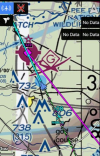- Joined
- Nov 3, 2020
- Messages
- 1,303
- Display Name
Display name:
Mahneuvers
So today I'm flying a practice approach. As I'm headed to the IAF, my SP and I watched another plane apparently headed for the same fix. I made a call earlier announcing my intentions as I thought we might be trying to do the same thing. Despite this and how I would have arrived first, this douche conoe (credit @schmookeeg for the expression) continues on his course. Fine. I announce an extended 360 to allow him to go 1st. He thanks me. I start the approach. DC announces flying the missed procedure, which means he'll be flying back the approach course. As we're headed straight for each other, within 500 feet, I break off my approach. I've never experienced such a clueless pilot. I made a snark remark on frequency as I broke off my approach.

